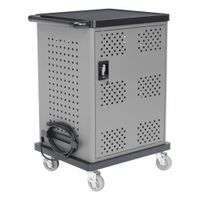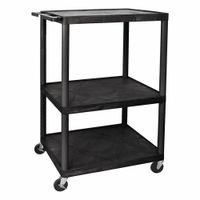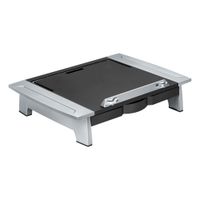Call +(254) 703 030 000 / 751 483 999 / 721 704 777
- Home
- Furnishings Appliances Hospitality
- Furniture
- Media Furniture
Frequently Asked Questions
What is the best media furniture for organizing electronic devices?
The best media furniture for organizing electronic devices combines functionality, aesthetics, and adaptability to accommodate various gadgets and accessories. A well-designed media console or entertainment center should offer ample storage, cable management solutions, and ventilation to ensure optimal performance and longevity of your devices.
1. **Storage and Shelving**: Look for furniture with adjustable shelves and compartments to accommodate different sizes of devices such as gaming consoles, streaming devices, and audio equipment. Closed cabinets can hide clutter, while open shelving allows for easy access and display of frequently used items.
2. **Cable Management**: Effective cable management is crucial to prevent tangling and maintain a clean appearance. Choose furniture with built-in cable management systems, such as grommets, channels, or clips, to route and conceal wires neatly.
3. **Ventilation**: Electronic devices generate heat, so proper ventilation is essential to prevent overheating. Opt for furniture with open backs or ventilation holes to ensure adequate airflow around your devices.
4. **Material and Design**: The material and design should complement your home decor while being durable enough to support the weight of your devices. Options like wood, metal, or glass can offer different aesthetic appeals and structural integrity.
5. **Modularity and Flexibility**: As technology evolves, your media setup may change. Modular furniture allows for reconfiguration and expansion, ensuring it remains functional as your needs grow.
6. **Additional Features**: Consider furniture with integrated power strips or charging stations for added convenience. Some advanced options even offer smart features like remote-controlled lighting or motorized lifts for TVs.
Ultimately, the best media furniture is one that meets your specific needs, fits your space, and enhances the overall look of your living area while keeping your electronic devices organized and accessible.
How do charging carts and stations work?
Charging carts and stations are designed to provide power to electronic devices, such as laptops, tablets, and smartphones, in a centralized and organized manner. They are commonly used in educational institutions, offices, and public spaces to ensure devices are charged and ready for use.
Charging carts are mobile units equipped with multiple slots or shelves to hold and charge several devices simultaneously. They typically include built-in power strips or USB ports, allowing each device to connect to a power source. The carts often feature cable management systems to keep cords organized and prevent tangling. Some advanced models offer smart charging technology, which optimizes the charging process by distributing power based on each device's needs, preventing overcharging and conserving energy.
Charging stations, on the other hand, are fixed installations that provide charging capabilities in a specific location. They can be wall-mounted or freestanding units with multiple charging ports. These stations often support various charging standards, such as USB-A, USB-C, and wireless charging, to accommodate different device types. Some stations include lockers or secure compartments to store devices while charging, offering added security in public or shared environments.
Both charging carts and stations may incorporate additional features like timers, which schedule charging during off-peak hours to reduce energy costs, and network connectivity, enabling remote monitoring and management. This connectivity allows administrators to track charging status, usage patterns, and perform updates or maintenance.
Overall, charging carts and stations streamline the charging process, enhance device management, and ensure that electronic devices are consistently powered and ready for use, supporting productivity and convenience in various settings.
What are the benefits of using media carts for multimedia equipment?
Media carts offer several benefits for managing multimedia equipment:
1. **Mobility**: Media carts are equipped with wheels, allowing easy transportation of multimedia equipment between rooms or locations. This mobility is particularly beneficial in educational and corporate settings where equipment needs to be shared across multiple spaces.
2. **Organization**: These carts provide structured storage with shelves and compartments, helping to keep equipment like projectors, laptops, and cables organized. This reduces clutter and makes it easier to locate and access equipment when needed.
3. **Space Efficiency**: Media carts are designed to maximize space usage, making them ideal for environments with limited space. They consolidate multiple pieces of equipment into a single, compact unit.
4. **Security**: Many media carts come with lockable cabinets or compartments, providing security for expensive equipment. This feature helps prevent theft and unauthorized access, ensuring that equipment is safe when not in use.
5. **Cable Management**: Media carts often include built-in cable management systems, which help to keep cords and cables tidy and prevent tangling. This not only improves the aesthetic appeal but also reduces the risk of tripping hazards.
6. **Versatility**: Media carts can accommodate a wide range of equipment, from audio-visual devices to computers and peripherals. This versatility makes them suitable for various applications, including presentations, training sessions, and conferences.
7. **Durability**: Constructed from robust materials, media carts are designed to withstand frequent use and movement. This durability ensures a long lifespan, providing a good return on investment.
8. **Ease of Use**: With features like adjustable shelves and ergonomic handles, media carts are user-friendly, making it easy for individuals to set up and operate multimedia equipment efficiently.
How do I choose the right monitor riser for my desk setup?
To choose the right monitor riser for your desk setup, consider the following factors:
1. **Height Adjustment**: Ensure the riser allows for ergonomic positioning, keeping the top of the monitor at or slightly below eye level. Adjustable risers offer flexibility for different users and setups.
2. **Size and Compatibility**: Match the riser size to your monitor's dimensions and weight. Check the riser's weight capacity to ensure it can support your monitor safely.
3. **Material and Build Quality**: Choose durable materials like metal, wood, or high-quality plastic. A sturdy build ensures stability and longevity.
4. **Design and Aesthetics**: Select a design that complements your desk and office decor. Consider color, finish, and style to maintain a cohesive look.
5. **Functionality and Features**: Look for additional features like built-in drawers, cable management, or USB ports for added convenience and organization.
6. **Space and Storage**: Consider the space under the riser for storing keyboards, documents, or other desk accessories. This helps in maintaining a clutter-free workspace.
7. **Portability and Ease of Assembly**: If you need to move the riser frequently, opt for a lightweight and easy-to-assemble model.
8. **Budget**: Determine your budget and find a riser that offers the best features within your price range. Balance cost with quality and functionality.
9. **User Reviews and Ratings**: Check online reviews and ratings to gauge user satisfaction and identify potential issues with specific models.
10. **Brand Reputation and Warranty**: Choose reputable brands known for quality products and good customer service. A warranty can provide peace of mind regarding product durability.
By considering these factors, you can select a monitor riser that enhances your desk setup ergonomically and aesthetically.
What features should I look for in a laptop riser?
When selecting a laptop riser, consider the following features:
1. **Adjustability**: Look for a riser with adjustable height and angle settings to ensure ergonomic comfort and reduce strain on your neck and back.
2. **Stability and Build Quality**: Choose a riser made from durable materials like aluminum or high-quality plastic. It should have a stable base to prevent wobbling or tipping.
3. **Portability**: If you need to move your setup frequently, opt for a lightweight and foldable design that is easy to transport.
4. **Ventilation**: Ensure the riser has a design that promotes airflow to prevent your laptop from overheating. Look for models with open frames or built-in fans.
5. **Weight Capacity**: Check the riser's weight limit to ensure it can support your laptop's size and weight without compromising stability.
6. **Cable Management**: Some risers offer built-in cable management features to keep your workspace organized and free from clutter.
7. **Compatibility**: Ensure the riser is compatible with your laptop size. Some risers are designed for specific sizes, while others are adjustable to fit a range of dimensions.
8. **Non-Slip Surface**: A non-slip surface or rubber pads can prevent your laptop from sliding off the riser.
9. **Aesthetic and Design**: Consider the design and color of the riser to match your workspace or personal style.
10. **Additional Features**: Some risers come with extra features like USB ports, built-in docks, or storage compartments for added convenience.
By considering these features, you can select a laptop riser that enhances your comfort, productivity, and workspace organization.
How can I secure my devices in a charging station?
To secure your devices at a charging station, follow these steps:
1. **Use a USB Data Blocker**: Employ a USB data blocker or "USB condom" to prevent data transfer while charging. This device allows only power to pass through, blocking any data exchange.
2. **Opt for Power-Only Cables**: Use cables designed for charging only, which do not support data transfer, reducing the risk of data theft.
3. **Avoid Public USB Ports**: Whenever possible, use your own charger and plug it into an electrical outlet instead of using public USB ports, which can be compromised.
4. **Enable Device Security Features**: Ensure your device's security features, such as screen locks, biometric authentication, and encryption, are enabled to protect your data.
5. **Keep Software Updated**: Regularly update your device's operating system and apps to protect against vulnerabilities that could be exploited through compromised charging stations.
6. **Use Portable Power Banks**: Carry a portable power bank to charge your devices without relying on public charging stations.
7. **Monitor Device Behavior**: Be vigilant for unusual behavior on your device after using a public charging station, such as unexpected pop-ups or apps, which could indicate malware.
8. **Disable Data Transfer**: Before connecting to a public charging station, disable data transfer options on your device, such as USB debugging or file transfer modes.
9. **Use a VPN**: If you must connect to a public network while charging, use a VPN to encrypt your internet traffic and protect your data.
10. **Be Aware of Surroundings**: Stay alert and keep an eye on your device while it is charging in public to prevent physical theft.
By following these precautions, you can significantly reduce the risk of data theft and ensure your devices remain secure while using public charging stations.
What are the advantages of using phone risers for ergonomic viewing?
Phone risers offer several ergonomic benefits that enhance user comfort and health. Firstly, they elevate the phone to eye level, reducing the need to bend the neck and thus minimizing strain on the cervical spine. This helps prevent "text neck," a common condition caused by prolonged downward gazing at screens. By maintaining a neutral neck position, users can avoid discomfort and potential long-term musculoskeletal issues.
Secondly, phone risers promote better posture. When the phone is at eye level, users are less likely to hunch over, which can lead to rounded shoulders and back pain. Improved posture not only reduces physical strain but also enhances breathing and circulation, contributing to overall well-being.
Additionally, phone risers can increase productivity. With the phone at a more accessible height, users can multitask more efficiently, such as typing on a computer while referencing information on their phone. This setup is particularly beneficial for professionals who need to manage multiple devices simultaneously.
Phone risers also offer flexibility and customization. Many models are adjustable, allowing users to find the optimal height and angle for their specific needs. This adaptability ensures that individuals of different heights and preferences can achieve a comfortable viewing experience.
Moreover, phone risers can help reduce glare and reflections on the screen by allowing users to adjust the angle, leading to less eye strain and improved visual clarity. This is particularly important for prolonged use, as it can prevent eye fatigue and headaches.
In summary, phone risers enhance ergonomic viewing by promoting better posture, reducing neck and eye strain, increasing productivity, and offering customizable viewing angles, all of which contribute to a healthier and more comfortable user experience.


